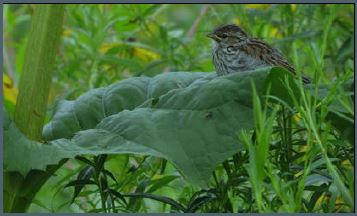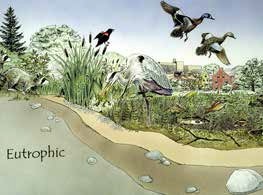Natural Resources Development
PROGRAM MISSION
UWEX Cooperative Extension Community Development Educators offer education, research and process solutions to government, business and non-profit clients. education, research and process solutions to government, business and non-profit clients in 68 of Wisconsin’s 72 counties.
Nature’s Birdfeeder
By Patrick Goggin, Lakes Specialist, UW-Extension Lakes
If you’re searching for a native wildflower to help in feeding and providing water to seed loving birds, look no farther than the cup plant, Silphium perfoliatum. This damp prairie beauty is distinguished by its

water that is slurped up by goldfinches, sparrows,
chickadees and other birds. – Photo by Paul Skawinski.
thick, tough, square/quadrangular stems and pairs of cupforming leaves. It is a sunflower-like plant, and typically grows to a height range of 4-8 feet, but can reach as high as 12 feet when older. Its flower heads stretch to three inches in diameter and feature delightful light yellow rays (20-40 )and darker yellow center disks which bloom in summer on the upper part of the plant from July to September. The leaves are rough to the touch, triangular to ovate in shape, coarselytoothed and opposite from each other on the stem.
In Wisconsin, this plant occurs chiefly in southwestern areas of the state at the edges of low woods, low wet prairies and river and stream banks of southern, wet forests. It is also common along open or shaded roadsides, fields and other rich and moist habitats like railroad rights-of-way, ponds and lake edges. As it is an important cultural plant for local Bad River, Lac du Flambeau and Menominee Nations in Wisconsin, cup plant occurs in several populations on tribal reservations because of long-ago introductions by American Indians. In North America, its native range extends from central-eastern Canada to the
southeastern portions of the United States. It is a close relative of other Silphium found here in Wisconsin, including compass plant, rosinweed and prairie dock.

Cup plants are also valuable to wildlife. The large leaves surrounding the stem are reservoirs providing birds and insects with drinking water. The sunflower-sized seeds are sought after by finches and sparrows and the flowers attract many bees and beneficial insects. The open, composite flower of the cup plant welcomes bee visitors of all kinds for the nectar, including bumble and cuckoo bees, long-horned bees, leafcutter bees, green sweat bees and miner bees of several species.
Cup plant is the larval host of silphium moths (Tabenna silphiella) and giant eucosma moths (Eucosma giganteana). Several species of skipper butterflies visit cup plant flowers for nectar including the fiery skipper butterfly (Hylephila phyleus) and eastern tiger swallowtail (Papilio glaucus).
Large aphid populations on the underside of cup plant leaves are common. Aphids (Uroleucon spp.) are small, soft-bodied insects that feed on plants by piercing through the plant tissue with their straw-like mouthparts and sucking out the liquid. Their waste material (aka honey dew) is sticky and sweet, which attracts a number of other insects to the plant, in particular, ants that feed on it. Katydids feed on cup plant leaves in early summer as well, and are common prey for parasitic wasps like grass-carrying, great black and great golden digger wasps. Still other insects use cup plant stems as their winter home to protect themselves from the cold temperatures.

Cup plant is a super plant for clay-like soils because its strong, fibrous roots penetrate into the clay, helping increase infiltration and water drainage. Although cup plant prefers moist, rich soils, it is easily grown in average, medium to wet soils in full sun, and even tolerates sandy soils and some drought once it’s established. It can be a little slow to establish when grown from seed, but it will come on strong after a year or two, and will self-seed in optimum growing conditions.
Cup plant is an expansive plant that needs lots of space. Some gardeners find cup plant to be too large and aggressive for border areas; instead, they utilize it in the backside of native plant beds like rain gardens and lakeshore plantings as an effective backdrop for perennials. It adapts well to prairies, wildflower/native plant gardens, naturalized areas or moist, open woodland areas including stream and lake edges. Good complimentary native plants to use with cup plant include spotted Joe-pye weed (Eutrochium maculatum) and swamp milkweed (Asclepias incarnata). Cup plant is a large, bold plant that brings form and texture to the landscape. Use it as a focal point in perennial gardens around your home landscape!

In the Know
Did you know lake foam can be a natural occurrence?Lake foam occurs naturally when organic compounds, such as plant and animal matter, decompose and are released into the water. This organic content contains surfactants, which are compounds that lessen the surface tension of the water. When these surfactants are rapidly mixed with the air, by wind, wave action, water flowing over a dam, or turbulent rapids, they will create foam in the water. This foam can build up and collect in coves and downstream, but naturally-occurring lake foam will subside and settle relatively quickly.
Lake foam is most common in eutrophic lakes that are dark brown in color. These lakes typically have high organic content from decomposing leaves and the presence of many plants and animals. You will see more lake foam in the late fall due to the release of organic compounds at the end of our growing season.
Beginning in the late 1950s, synthetic laundry detergents containing surfactants made their way into waterbodies and caused massive foam production and buildup. These detergents and other soaps were chemically non-biodegradable, so they hung around for a long time. Phosphorus in these detergents also created biological overproduction – similar to the phosphorus-related problems we still see today. After conflict over the issue i n the early years of environmental protection, the industry now produces household products that are much safer for our waterbodies. The sudsing agent of all detergents now on the market must be biodegradable. This effort, combined with advances in water treatment, regulation, and education, has significantly decreased the amount of lake foam from pollution.
n the early years of environmental protection, the industry now produces household products that are much safer for our waterbodies. The sudsing agent of all detergents now on the market must be biodegradable. This effort, combined with advances in water treatment, regulation, and education, has significantly decreased the amount of lake foam from pollution.
Is it natural or not?
Natural foam has an earthy or fishy aroma, is off-white, tan, or brown in color, and is common in rainy or windy conditions. Foam from pollution will likely smell of perfume, be whiter in color, slimy to the touch, and will not travel very far.
Written by Kirstin James, UWSP graduate, for Lake Tides
Illustration by Carol Watkins
_________________________________________________________________________________________________
Have you ever wondered what is so tasty below the surface that makes ducks dive for their dinner? It’s water celery! Click on the link below to read more.
- Kewaunee Recycling Guide pdf
- Department of Natural Resources
- National Recycling Coalition
- WasteCap
- Environmental Resources Center
- Well Water Quality Viewer
- Wisconsin Woodlands Information
_______________________________________________________________________________________________
STAFF
If you have any questions regarding Community Resource Development in Kewaunee County, please contact:
Patrick Nehring
Community Development Educator
920-391-4616
patrick.nehring@wisc.edu
Erin Dahle – Program Assistant
Phone: 920-388-7141





